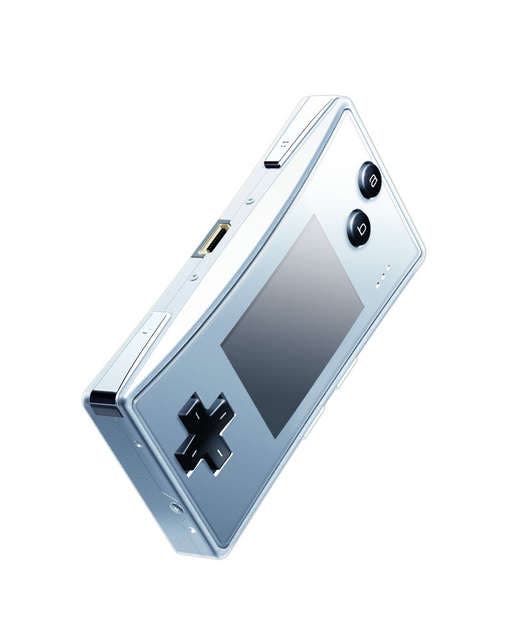Game Boy Micro
Shine get!
I wonder if I can get away with reviewing it like this. Probably not. Might be fun to stick with it though. Voices-in-the-head kinda thing.
The Game Boy Micro, then, is Nintendo's answer to...
Hang on. Why the hell have they made this? The GBA SP, which is being quietly relaunched right now with a brighter screen, costs just a few quid more and - particularly given the screen change - is simply a better toy. The Micro is a very small Game Boy Advance with a very bright screen; it has a headphone socket, which you can't get on the SP without a silly little peripheral that I've never been able to find; and the directional pad and buttons are spongier, which is a pleasant alteration. But the SP plays my old copy of Tetris and the Micro doesn't, and you have to pay extra to use your old link cables. Do they honestly expect me to pay £69.99 for this?
Well, now we come to it, no - they don't. I can if I want - that's if I want a very small handheld with a very bright screen and the option of (soon to be) collectible interchangeable faceplates - but I'm not really expected to. As Satoru Iwata said at the Tokyo Game Show, the GB Micro is part of Nintendo's three-pronged strategy to expand the gaming populace, to attract disillusioned gamers back into the fold, and to keep the hardcore happy. Specifically, it's targeting people who don't necessarily want a bulky (or, in the SP's case, bulky-ish) handheld, but might be interested if it looked good, slotted into a jeans pocket and had lots of fun little games. The faceplate stuff adds some value there and, to a lesser extent, satisfies those elements of the hardcore with plenty of disposable income - the sort of folks who saw the Famicom (NES) faceplate and thought, "Crikey, I'm sold."
In other words, it is the answer, in a sense, but not to a question that we're asking. Those of you who want one don't need to see a score - you were probably convinced by the first photographs and testimonials, and as much as you might lament the need to pay extra for peripherals that allow link-up and wireless play, they're not factors that'll weigh into your thought process when you reach the till. And, let's be honest, the people who don't play games or gave up on games a while ago because things were becoming more and more adventitious with each iteration aren't reading this website.
Although apparently I am reading Word of the Day.
Still, we can at least ask ourselves this: Is the Game Boy Micro good enough to do what it sets out to do?

Look back to the introduction, and you'll see that I described the GBA SP as "a better toy", a term I didn't apply to the Micro. That wasn't actually deliberate, it just came out that way; but it's certainly a distinction worth emphasising. The Micro looks very sharp - the stylish lines that curve inward atop and below the screen, lending definition to the shiny and reflective faceplates; the metallic glint of the shoulder buttons, which depress in the centre rather than at the edge; the initial glow of the Start and Select buttons when you fire it up; the rather chic-y lowercase "b" and "a" buttons; it's a unit rather than a toy. It may be light to the point of implying flimsiness (an unfair implication, as it goes), and the games may be colourful - largely drawn from the annals of 8- and 16-bit software - but aesthetically it's treading on ground closer to Sony's PlayStation Portable or Apple's iEverything devices than anything Nintendo's released. It's a bit like the Panasonic Q of the Game Boy line - like the Q, which was just a shiny GameCube with DVD playback, you've no real reason to buy it, but you do kind of want one.
It's not as stylish as the PSP, but it's definitely quite gorgeous and it's very robust compared to Sony's model. I've dropped the Micro from a height of around a metre and it was fine. If it spills out of your jeans it'll probably be fine unless someone steps on it - and while the faceplate may scratch it can be snapped off and replaced. It also has five brightness settings accessed through a digital audio/brightness-adjust button on the side, so you don't have to cane the battery too hard unless you need to - and that's a rechargeable laptop-style battery, too, which lasts for absolutely hours.
In other words, yes, it's probably going to appeal to the people that Nintendo are targeting with it. It lacks a suspend mode, the peripherals cost extra, and it's also worth noting that the sound from the built-in speaker is pretty tinny; but what it lacks there it makes up for with its elegance, convenience and robustness. Tell your friends - and if you happen to buy one because you can't help yourself, I won't judge you.
Cos, well, it's really, really shiny, isn't it?
Game Boy Micro launches in Europe on November 4th priced £69.99 or thereabouts.








